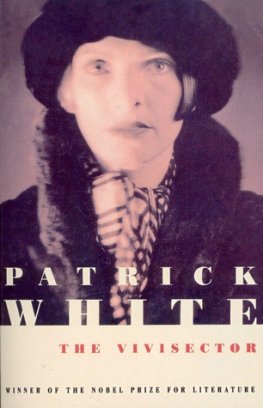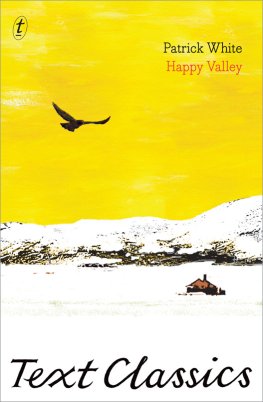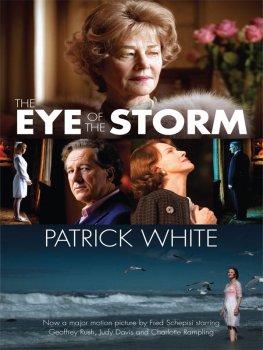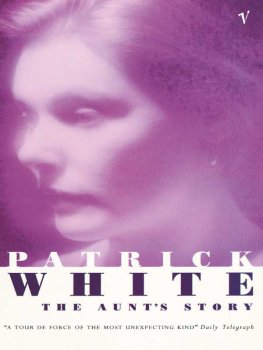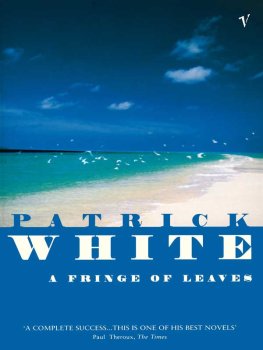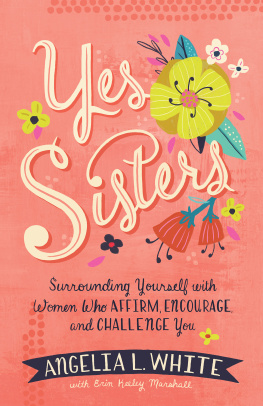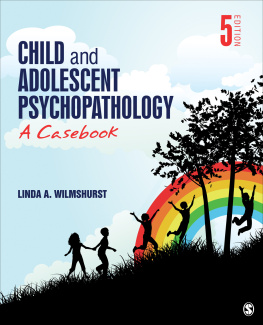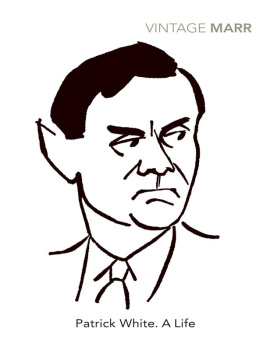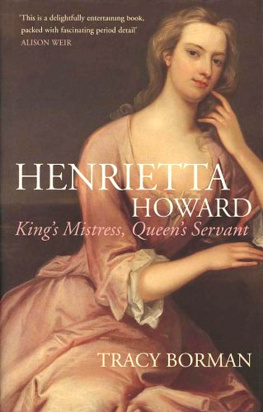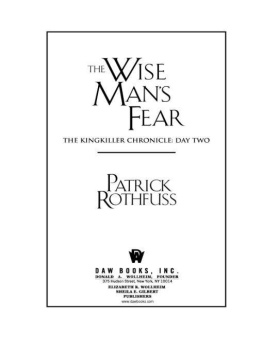Patrick White
The Vivisector
PATRICK WHITE was born in England in 1912, when his parents were in Europe for two years; at six months he was taken back to Australia, where his father owned a sheep station. When he was thirteen, he went to school in England, to Cheltenham, where it was understood, the climate would be temperate and a colonial acceptable. Neither proved true, and after four rather miserable years there he went to Kings College, Cambridge, where he specialized in languages. After leaving the university he settled in London, determined to become a writer. His first novel, Happy Valley, was published in 1939 and his second, The Living and the Dead, in 1941. During the war he was an RAAF intelligence officer in the Middle East and Greece. After the war he returned to Australia.
His novels include The Aunts Story (1946), The Tree of Man (1956), Voss (1957), Riders in the Chariot (1961), The Solid Mandala (1966), The Eye of the Storm (1973), A Fringe of Leaves (1976), and The Twyborn Affair (1979). He also published two collections of short stories, The Burnt Ones (1964) and The Cockatoos (1974), which incorporates several short novels, a collection of novellas, Three Uneasy Pieces (1987), and his autobiography, Flaws in the Glass (1981). He also edited Memoirs of Many in One (1986). In 1973 he was awarded the Nobel Prize in Literature.
Patrick White died in September 1990. In a tribute to him The Times wrote, Patrick White did more than any other writer to put Australian literature on the international map. . His tormented oeuvre is that of a great and essentially modern writer.
J. M. COETZEE born in South Africa in 1940 and educated in South Africa and the United States. Among his academic appointments have been professorships at the University of Cape Town and the University of Chicago. He is the author of numerous works of fiction, as well as of memoirs, criticism, and translations. Among the awards he has won are the Booker Prize (twice) and, in 2003, the Nobel Prize in Literature. Since 2002 he has lived in Adelaide, Australia.
For Cynthia and Sidney Nolan
As I see it, painting and religious experience are the same thing, and what we are all searching for is the understanding and realization of infinity.
BEN NICHOLSON
Cruelty has a Human Heart,
And Jealousy a Human Face;
Terror the Human Form Divine,
And Secrecy the Human Dress.
The Human Dress is forged in Iron,
The Human Form a fiery Forge,
The Human Face a Furnace seald,
The Human Heart its hungry Gorge.
WILLIAM BLAKE
They love truth when it reveals itself, and they hate it when it reveals themselves.
SAINT AUGUSTINE
He becomes beyond all others the great Invalid, the great Criminal, the great Accused One and the Supreme Knower. For he reaches the unknown.
RIMBAUD
Patrick White was born in 1912 into a wealthy New South Wales family, owners of hundreds of thousands of acres of prime grazing land. Young Patrick was not an attractive child, withdrawn, unsmiling; he also suffered from chronic asthma. At the age of twelve he was packed off to England to a public (that is, private) school, where he spent five unhappy years. By the time he came home in 1929 a tendency toward self-loathing had become entrenched. He was also a secret homosexual.
Back in Australia, he worked for a while as a farmhand on the estate of family friends, and discovered in himself an unexpected love of the wilder reaches of the landscape. In his leisure time he wrote busily.
Hoping that he might make a career for himself in the diplomatic corps, his parents sent him to Cambridge University, whence he emerged in 1935 with a solid if undistinguished degree in French and German literature. A collection of his poems came out in Sydney, the printers bill paid by his mother, who also subsidized performances of a play he had written.
After Cambridge, White declared he was going to be a writer and on an allowance of four hundred pounds a year took up residence in London. His situation became even more comfortable on the death of his father in 1937, when a substantial legacy came to him (he would have to wait until the death of his mother, however, before receiving the bulk of his inheritance). Never in his life would he find it necessary to take paid employment.
White was not the first Australian intellectual who, seeing no future for himself at home, took the route of expatriation. His first novel, Happy Valley, appeared in London in 1939, with endorsements by Graham Greene, Elizabeth Bowen, and Herbert Read, and won praise from the critics. In Australia it had a more guarded reception: it misrepresented country life, said reviewers, and its style was unnecessarily difficult. His second novel, The Living and the Dead (1941), came out first in the United States, and was ignored in Australia.
In 1940 White enlisted in the Royal Air Force and was sent to North Africa as an intelligence officer. There he met a Cairene Greek named Manoly Lascaris, who became his lover and with whom he would live for the rest of his life. After the war he embarked with Lascaris on what was intended to be no more than a visit to old Australian haunts their long-term plan was to settle in Greece and run an export-import business but instead turned into permanent residence. Some twenty-five miles from the centre of Sydney they bought a smallholding, where they grew flowers and raised thoroughbred dogs for sale. The indifference with which his third novel, The Aunts Story (1947), was received plunged White into gloom, and for years he gave up writing. Then, after what seems to have been a mystical illumination, he began work on a book that became The Tree of Man.
The feeling he had rediscovered in himself for the Australian landscape, which reduced him to silence, simplicity and humility. . the only proper state for the artist as for the human being, did not extend to Australian society. He was dismayed by the pressure toward conformity, as well as by the immersion of the middle class in the single-minded pursuit of money. A spirit of prudishness reigned, expressed in a tight censorship system and a general policing of morals: In a notorious case, the conductor of the Sydney Symphony Orchestra was arrested after a trip abroad for having girlie magazines in his briefcase and had to flee the country under threat of prosecution for the crime of scandalous conduct. Whites sense of isolation grew as he watched the land around the smallholding being gobbled up for housing developments. Riders in the Chariot, in which a small company of artists and visionaries is subjected to the (as he saw it) malevolent small-mindedness and xenophobia of the suburbs, expressed in extreme form his alienation from the social world.
The loneliness and suffering of the artist of the sexual deviant too reviled or persecuted or expelled or ostracized for telling truths that the multitude cannot bear, is a recurrent theme in Whites work. Though its hero is not an artist, Voss (1957), the novel for which he became best known, embodies the late Romantic myth by which White lived and from which he drew sustenance. Johann Ulrich Voss, explorer by vocation, ventures into the forbidding interior of the Australian continent; in the course of suffering and dying there, he gains visionary insight into the mysteries not only of the land but also of human existence, and of the human heart.
It was hardly to be expected that a writer who saw himself as marked out for a special, higher destiny would be taken to the bosom of democratic Australia. White made his first real mark not at home, nor indeed in England, but in the United States, where as early as 1939 Ben Huebsch of Viking Press recognized him as the kind of ambitious, experimental modernist he wanted to foster, and became his devoted publisher.

